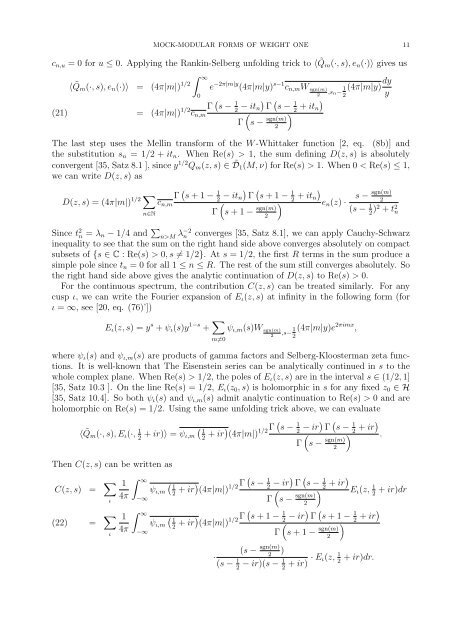Mock-modular forms of weight one - UCLA Department of Mathematics
Mock-modular forms of weight one - UCLA Department of Mathematics
Mock-modular forms of weight one - UCLA Department of Mathematics
You also want an ePaper? Increase the reach of your titles
YUMPU automatically turns print PDFs into web optimized ePapers that Google loves.
MOCK-MODULAR FORMS OF WEIGHT ONE 11<br />
c n,u = 0 for u ≤ 0. Applying the Rankin-Selberg unfolding trick to 〈 ˜Q m (·, s), e n (·)〉 gives us<br />
∫ ∞<br />
〈 ˜Q m (·, s), e n (·)〉 = (4π|m|) 1/2 e −2π|m|y (4π|m|y) s−1 c n,m W sgn(m)<br />
0<br />
= (4π|m|) 1/2 Γ ( s − 1<br />
c − it ) (<br />
2 n Γ s −<br />
1<br />
+ it )<br />
2 n<br />
(21)<br />
n,m ( )<br />
Γ s − sgn(m)<br />
2<br />
2 ,s n− 1 2<br />
(4π|m|y) dy<br />
y<br />
The last step uses the Mellin transform <strong>of</strong> the W -Whittaker function [2, eq. (8b)] and<br />
the substitution s n = 1/2 + it n . When Re(s) > 1, the sum defining D(z, s) is absolutely<br />
convergent [35, Satz 8.1 ], since y 1/2 Q m (z, s) ∈ ˜D 1 (M, ν) for Re(s) > 1. When 0 < Re(s) ≤ 1,<br />
we can write D(z, s) as<br />
D(z, s) = (4π|m|) ∑ 1/2 Γ ( s + 1 − 1<br />
c − it ) (<br />
2 n Γ s + 1 −<br />
1<br />
+ it )<br />
2 n s − sgn(m)<br />
n,m (<br />
)<br />
2<br />
e n (z) ·<br />
n∈N<br />
Γ s + 1 − sgn(m)<br />
(s − 1<br />
2<br />
2 )2 + t 2 n<br />
Since t 2 n = λ n − 1/4 and ∑ n>M λ−2 n converges [35, Satz 8.1], we can apply Cauchy-Schwarz<br />
inequality to see that the sum on the right hand side above converges absolutely on compact<br />
subsets <strong>of</strong> {s ∈ C : Re(s) > 0, s ≠ 1/2}. At s = 1/2, the first R terms in the sum produce a<br />
simple pole since t n = 0 for all 1 ≤ n ≤ R. The rest <strong>of</strong> the sum still converges absolutely. So<br />
the right hand side above gives the analytic continuation <strong>of</strong> D(z, s) to Re(s) > 0.<br />
For the continuous spectrum, the contribution C(z, s) can be treated similarly. For any<br />
cusp ι, we can write the Fourier expansion <strong>of</strong> E ι (z, s) at infinity in the following form (for<br />
ι = ∞, see [20, eq. (76)’])<br />
E ι (z, s) = y s + ψ ι (s)y 1−s + ∑ ψ ι,m (s)W sgn(m)<br />
,s− 1 (4π|m|y)e 2πimx ,<br />
2 2<br />
m≠0<br />
where ψ ι (s) and ψ ι,m (s) are products <strong>of</strong> gamma factors and Selberg-Kloosterman zeta functions.<br />
It is well-known that The Eisenstein series can be analytically continued in s to the<br />
whole complex plane. When Re(s) > 1/2, the poles <strong>of</strong> E ι (z, s) are in the interval s ∈ (1/2, 1]<br />
[35, Satz 10.3 ]. On the line Re(s) = 1/2, E ι (z 0 , s) is holomorphic in s for any fixed z 0 ∈ H<br />
[35, Satz 10.4]. So both ψ ι (s) and ψ ι,m (s) admit analytic continuation to Re(s) > 0 and are<br />
holomorphic on Re(s) = 1/2. Using the same unfolding trick above, we can evaluate<br />
〈 ˜Q m (·, s), E ι (·, 1 + ir)〉 = ψ ( 1 2 ι,m + ir) (4π|m|) 1/2 Γ ( s − 1 − ir) Γ ( s − 1 2 ( ) + ir) 2 .<br />
2<br />
Γ s − sgn(m)<br />
2<br />
Then C(z, s) can be written as<br />
C(z, s) = ∑ ι<br />
(22)<br />
= ∑ ι<br />
∫<br />
1 ∞<br />
4π −∞<br />
∫<br />
1 ∞<br />
4π −∞<br />
(<br />
ψ 1<br />
ι,m + ir) (4π|m|) 1/2 Γ ( s − 1 − ir) Γ ( s − 1 2<br />
( ) + ir) 2<br />
E<br />
2 ι (z, 1 + ir)dr<br />
Γ s − sgn(m)<br />
2<br />
2<br />
(<br />
ψ 1<br />
ι,m + ir) (4π|m|) 1/2 Γ ( s + 1 − 1 − ir) Γ ( s + 1 − 1<br />
(<br />
2<br />
)<br />
+ ir) 2<br />
2<br />
Γ s + 1 − sgn(m)<br />
2<br />
(s − sgn(m) )<br />
2<br />
·<br />
(s − 1 − ir)(s − 1 + ir) · E ι(z, 1 + ir)dr.<br />
2<br />
2 2
















